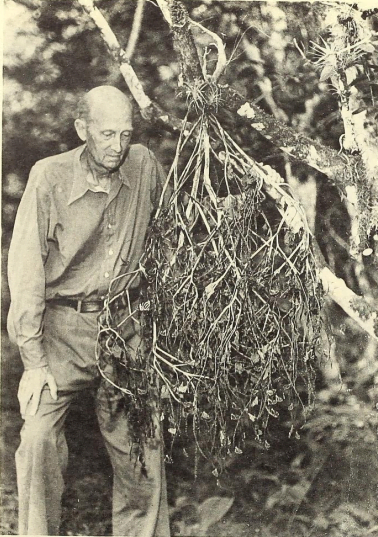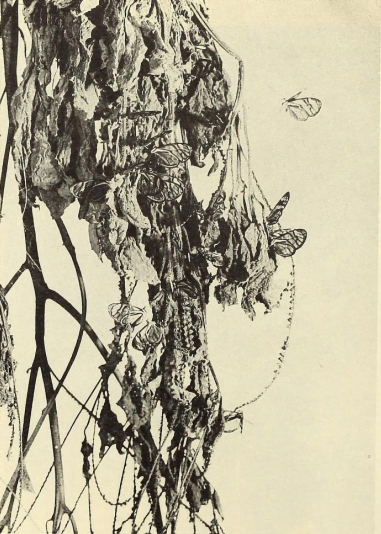We recorded small numbers of two species of Danaidae, the first of which, Danaus plexippus megalippe (Hiibner), is the tropical representative of our northern Monarch. The striking Lycorea ceres ceres (Cramer) was present in numbers and the same individuals often returned day after day, conspicuous in their ithomiid type of pattern and coloring.
There seems little doubt that the first appeal of the attraction of fedegoso is through the olfactory senses of the Lepidoptera, as evinced by the approach upwind, together with the total lack of advertising or directive coloring in the plant.

Soon after the insect alights, or occasionally just before, the tongue unrolls, the tip probing and prodding about as the organ comes into function. Careful examination of the surface tissues of fedegoso fails to reveal any evidence of liquid drops or other source of nourishment.
Nevertheless, so potent is some such aliment that it affects the whole behavior of the insects. After a short period of feeding the insect loses its timidity and will often permit itself to be picked up by the wings, examined and replaced, or it may be captured by gently slipping a glass vial over it. When crowds of ithomiids are clustered close together, they will often buffet one another without taking flight.
During this first season nothing was done about chemical or other study of the nutritive substance of fedegoso. While it exerts a noticeable effect on the reduction of the escape reaction, this is in no sense through what might be called intoxication, as in the case of butterflies feeding on fermenting fruit. The insects show an obvious reluctance to leave their repast, but once on the wing, their flight is swift, accurate and typical. They quickly return to their feeding on leaf or raceme.

A quotation from the notes on fedegoso in Para, Brazil, by A. Miles Moss will present the similarities and the differences of our observations on the same plant. The suspended, dried plants, he says, “constitute a most remarkable attraction for the great majority, though not all, of the species of Syntomidae [Euchromidae], as well as for the closely related Arctiidae; also for many Danaiid butterflies, particularly the Ithomiinae, for wasps of many kinds, for a few beetles, for grasshoppers, for bugs, mosquitoes and flies of all sorts.” Aside from Lepidoptera, there is considerable discrepancy between recorded visitors as observed at Para and at Simla. At the former place in Brazil numerous nonlepidopteran visitors were observed. In our experience, such insects are rare or absent. In the case of mosquitoes, Hagmann indicates that they divide their interest between fedegoso and the observer, who is attacked “unmercifully.”
Of the non-lepidopterans we noted only three species of wasps, which occurred rarely, and on plants desiccated for more than two weeks, so old that they had lost their attractiveness for moths and butterflies. Besides this, there were two species of small longicoms which, on four occasions, were found, usually in pairs, wandering about the dry foliage. Now and then we had hints of minor adaptations and inter-relationships beginning to take shape on our fedegoso. Twice we found flower spiders and once an orbweaver trapping and devouring unwary euchromids. On another occasion a mantid had found the dry vegetation good hunting and was holding a euchromid in the grip of its forelegs, and a ponerine ant was discovered carrying off an ithomiid. The several times that we discovered butterflies sleeping on the same twig from which they had been feeding during the day suggested opportunities for new arthropod relationships.
Heliotropium is a genus of plants of the borage family, Boraginaceae, and the thought occurred to us that botanical consanguinity might carry with it some of this mysterious attraction for insects. Miss Kenedy made a few preliminary experiments with shrivelled twigs and leaves of two species of the genus Cordia, namely, C. alliodora or Cypre, and C. cylindrostachya or Black Sage. These gave no positive results.
Of a third genus of the borage family, Tournefortia, we had no available material. Upon our return to New York we received a letter from Dr. P.A. Buxton referring us to notes made by himself, 1926, and by Mr. G.H.E. Hopkins (1927) on trees of this genus growing on Samoa and other Pacific islands. Dr. Buxton writes that he found that “males of the genus Euploea of several species, in several different islands in the South Pacific, occur in numbers on withered twigs of the tree Tournefortia. The insect does not feed on that tree and the butterflies do not visit the flowers of that tree. The observations were made repeatedly but one cannot explain them.”
This gives hope that more extensive experimentation with members of the borage family may reveal other related plants that share this attractant quality.
